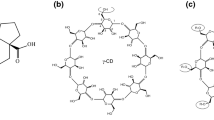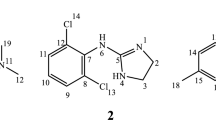Abstract
Conventional drugs are usually formulated for the immediate release of the medicinal substances and for obtaining the desired therapeutic effect. The aim of this paper was to investigate the possible interactions between Vitamin B10 and β-cyclodextrin (β-CD), to determine the physical-chemical characteristics and the interactions present in the corresponding inclusion compound. The so-obtained compounds were characterized by X-ray diffraction, DSC and FTIR spectroscopy. 1H NMR and UV–vis spectroscopic methods were employed to study the inclusion process in aqueous solution. The X-ray powder diffraction patterns demonstrate the inclusion compound formation, especially for the lyophilized product where the amorphous phase dominates. The existence of the inclusion compounds obtained by different methods was confirmed by comparing with DSC and FTIR data of the pure compounds and the (1:1) Vitamin B10:β-CD physical mixture (pm). 1H NMR measurements on aqueous solutions of Vitamin B10 and β-CD in D2O allowed us to establish the corresponding Vitamin B10’s and cyclodextrin’s protons implied in the complexation process. 2D NMR spectroscopy established the geometry of the inclusion complex. 1H NMR, UV–Vis and fluorescence data were used to obtain the stoichiometry and the stability constant of the complex.













Similar content being viewed by others
References
Vasilieva, S.: Para-aminobenzoic acid inhibits a set of SOS functions in E. coli K12. Mutat. Res. 496, 89–95 (2001)
Bruze, M., Gruvberger, B., Thulin, I.: PABA, benzocaine and other PABA esters in sunscreens and after-sun products. Photodermatol. Photoimmunol. Photomed. 7, 106–108 (1990)
Mackie, B.S., Mackie, L.E.: The PABA story. Aust. J. Dermatol. 40, 51–53 (1999)
Schmidt, T.C., Petersmann, M., Kaminski, L., Loew, V., Stork, E., Fresenius, G.: Analysis of aminobenzoic acids in waste water from a former ammunition plant with HPLC and combined diode array and fluorescence detection. J. Anal. Chem. 357, 121–126 (1997)
Szejtli, J., Osa, T.: Comprehensive Supramolecular Chemistry: vol. 3 Cyclodextrins. Pergamon, copyrighted material. Elsevier Science Ltd, Oxford (1996)
Sanchez de la Blanca, E., Nuñez, J.L., Martinez, Y.P.: Espectros de vibraciones de algunos acidos benzoicos p-substituidos. An. Quím. 82, 480–489 (1986)
Lu, C.S., Hu, C.J., Yu, Y., Meng, Q.J.: The inclusion compounds of β-cyclodextrin with 4-substituted benzoic acid and benzaldehyde drugs studied by proton nuclear magnetic resonance spectroscopy. Chem. Pharm. Bull. 48, 56–59 (2000)
Lai, T.F., Mash, R.E.: The crystal structure of p-amino benzoic acid. Acta Crystallogr. 22, 885–893 (1967)
Castro-Hermida, J.A., Gomez-Couso, H., Ares-Mazas, M.E., Gonzales-Bedia, M.M., Castaneda-Cancio, N., Otero-Espinar, F.J., Blanco-Mendez, J.: Anticryptosporidial activity of furan derivative G1 and its inclusion complex with beta-cyclodextrin. J. Pharm. Sci. 93, 1197–1206 (2004)
Rotich, M.K., Brown, M.E., Glass, B.D.: Thermal studies on mixtures of benzoic and salicylic acids with cyclodextrins. J. Therm. Anal. 73, 671–686 (2003)
Terekhova, I.V., Kumeev, R.S.: Inclusion complex formation of α- and β-cyclodextrins with amino benzoic acids in aqueous solution studied by 1H NMR. J. Incl. Phenom. Macrocycl. Chem. 59, 301–306 (2007)
Stalin, T., Shanthi, B., Vasantha Rani, P., Rajendiran, N.: Solvatochromism, prototropism and complexation of para-aminobenzoic acid. J. Incl. Phenom. Macrocycl. Chem. 55, 21–29 (2006)
Dey, J.K., Dogra, S.K.: Solvatochromism and prototropism of 2-(3′-hydroxyphenyl)benzoxazole and 2-(4′-hydroxyphenyl)benzoxazole in the excited singlet state. J. Photochem. Photobiol. A: Chem. 59, 307 (1991)
Shaomin, S., Yu, Y., Jinghao, P.: Study on molecular recognition of para-aminobenzoic acid species by α-, β- and hydroxypropyl-β-cyclodextrin. Anal. Chim. Acta 458, 305–310 (2002)
Wang, Z.P., Tang, X.D., Ding, Z.J.: Raman and photoluminescence spectroscopy study of benzoic acid at high pressures. J. Phys. Chem. Solids 66, 895–901 (2005)
Benesi, H.A., Hildebrand, J.H.: A spectrophotometric investigation of the interaction of iodine with aromatic hydrocarbons. J. Am. Chem. Soc. 71, 2703–2707 (1949)
Harata, K.: Induced circular dichroism of cycloamilose complexes with meta- end para-disubstituted benzenes. Bioorg. Chem. 10, 255–265 (1981)
HyperChemTM Release 4. Hypercube Inc., Waterloo, ON, Canada (1994)
Computational Chemistry. Hypercube Inc., Waterloo, ON, Canada (1994)
Steiner T., Koellner G.: Crystalline β-cyclodextrin hydrate at various humidities: fast, continuous, and reversible dehydration studied by X-ray diffraction. J. Am. Chem. Soc. 116(12), 5122–5128 (1994)
Fatiha, M., Djameleddine, K., Leila, L.: Molecular modeling study of para amino benzoic acids recognition by β-cyclodextrin. Orbital 1, 26–37 (2009)
Acknowledgments
The authors kindly acknowledge the financial support from the Romanian Ministry of Research and Education, Core Project PN-09-44 02 01. Special thanks are due to Drs. M. Bogdan and A. Pirnau for measuring and valuable suggestions as concerned 2D NMR experiments and to Dr. Simina Dreve for valuable discussions on fluorescence spectra.
Author information
Authors and Affiliations
Corresponding author
Rights and permissions
About this article
Cite this article
Kacsó, I., Borodi, G., Farcas, S.I. et al. Host–guest system of Vitamin B10 in β-cyclodextrin: characterization of the interaction in solution and in solid state. J Incl Phenom Macrocycl Chem 68, 175–182 (2010). https://doi.org/10.1007/s10847-010-9763-y
Received:
Accepted:
Published:
Issue Date:
DOI: https://doi.org/10.1007/s10847-010-9763-y




